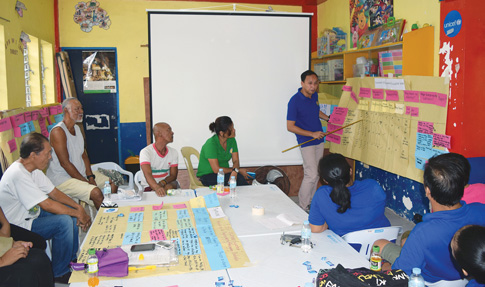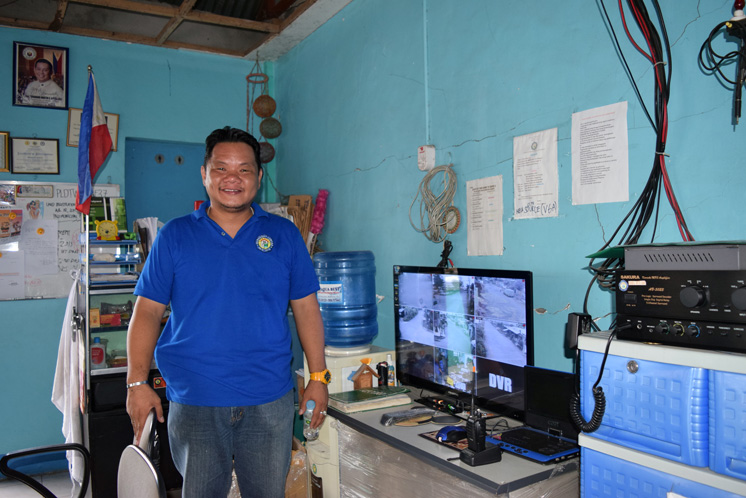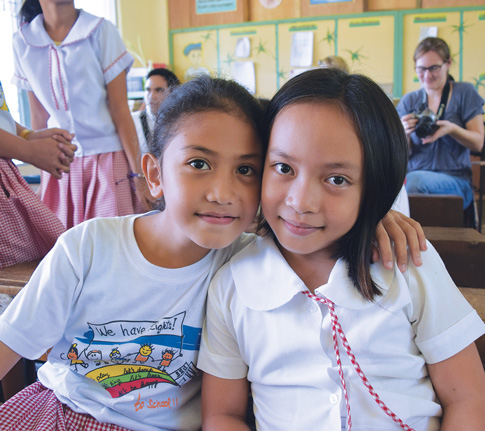In October, Tablet reporter Maria-Pia Negro Chin spent a week in the Philippines on a reporting fellowship with Catholic Relief Services. This is the fourth and final installment of the Haiyan Recovery series.

Two years after Super Typhoon Haiyan hit the Philippines, community members in a small town met to discuss how to survive another typhoon, what to do in case of an earthquake and how to plan for a tsunami. Overseeing them was Andres Sevilla, who helped to save the town of Luntad after Haiyan and is now leading its disaster preparedness efforts.
On Nov. 8, 2013, Sevilla and his family of nine swam to their neighbor’s house once the black sea water from the storm surge quickly rose to 16 feet. Afterward, they went to see what was left of their house and share their food with those who had lost everything.
“People were sharing because that was the key to survive,” he said.
Community also was crucial. Two days after the storm flattened his town, Sevilla, who was the barangay’s captain, called a community meeting in front of a nearby college. There, he explained to 825 townspeople that to keep the town safe they needed to form task forces. These included groups in charge of the town’s safety, people looking for food, cleaning debris and others building temporary shelters. “We had to unite in order to survive,” he said.
Members of Luntad, Palo, were among hundreds of thousands affected by Haiyan, which destroyed parts of the Philippines. The Category 5 storm left more than 6,300 dead and displaced close to a million. Many of the approximately 16 million Filipinos living in extreme poverty were affected, especially in municipalities in Eastern Leyte, where Luntad is located. The typhoon also resulted in $15 billion economic losses, including damaged or destroyed infrastructures. Prone to typhoons and flooding, Leyte was catastrophically damaged by Haiyan (locally known as Yolanda).

After Haiyan damaged the municipality’s power plant, Luntad and nearby towns spent two months without electricity, Sevilla said. Their recovery process begun in 2014, when Catholic Relief Services (CRS) started their shelter program.
“After Yolanda we are so hopeless that nobody will help us but then CRS came by,” he added.
CRS supported 200,000 typhoon survivors with emergency shelter, clean water and sanitation and helped to remove tons of debris. During the first two years after Haiyan, CRS has helped provide disaster-resistant housing and shelter with clean water and sanitation to thousands. In the next three years, CRS will continue helping those most vulnerable who need additional support in order to rebuild.
Luntad has been one of the areas that recovered quickly. More than 95 percent of the population repaired their houses with the help of CRS. But, like in many areas, people still need to recover their livelihoods. CRS is working with Caritas and USAID in a livelihood program so 9,000 families can stabilize their lives in some areas of Leyte and Samar.
Another big concern of Sevilla’s is preparedness and risk reduction.
“After Yolanda, there were many lessons learned,” especially after townspeople were killed and injured, he said. That is why it is important to come up with “a strong preparation for coming disasters.”
CRS, with USAID funding, is working in the municipalities of Palo and Tanauan to implement planning for resilience and effective preparedness. It starts at the household level, promoting awareness and participation to reduce the risk in case of disasters.
Planning for Survival
Barangay Luntad is one of 40 villages where 400 zone leaders are leading risk assessments and mapping techniques to locate high ground and vulnerable infrastructures. After community leaders come up with a detailed plan, they will work with 18,000 households to write down what to do after hearing the first warning signal.
Now Sevilla’s village is one of the most advanced in disaster preparedness. He said community members were traumatized by Haiyan and they “might not be able to handle” a typhoon that strong. This way the disaster preparedness planning “would be our key to survival.”

At a nearby town, the psychological impact the typhoon had on the students has made the school’s typhoon drills important.
Tanghas is a K-6 school with four teachers and 131 students. After Haiyan nearly destroyed the school, classes resumed in December under a temporary learning shelter with no walls. The school was repaired around May, 2014 while students slowly returned.
“We didn’t come to school because we were searching for food,” said fifth grader Neamae Varona. She was grateful that her family’s home was not completely destroyed and that she was able to return to school in January. She wants to study information technology when she grows up.
Teachers said a change brought about by Haiyan is a mandate to include emergency education and climate change adaptation to the school’s curriculum.
According to the World Risk report published in 2014, the Philippines is the second country with the highest risk of falling victim to a disaster resulting from an extreme natural event.
Like CRS and the local Caritas organizations managed by the Church, government organizations hold seminars and trainings so people can be prepared. The government’s national Climate Change Commission has a long-term program to strengthen stakeholder’s institutional capacity to manage risks, including new flood maps.
The Catholic Bishops’ Conference of the Philippines is taking “all possible approaches” to help their flock. This included church members signing the Global Catholic Climate Movement’s appeal to world leaders attending the UN climate summit in Paris Nov. 30 – Dec. 11. Leaders at the summit are trying to come up with agreement to curb rising global temperatures.
One of the 600,000 people from around the world that signed the petition included Manila Archbishop Luis Antonio Tagle, who is president of Caritas Internationalis, a global confederation of Catholic organizations working on behalf of the poor. Soon after Pope Francis’ speech at the U.N. General Assembly in September, the cardinal talked about climate change in his country and the papal encyclical “Laudato Si’” from a pastoral perspective.
“We have been getting typhoons with intensities that we have not seen before. We cannot explain (them) scientifically, but we live through all of those,” he told the National Catholic Reporter. “We have seen how poor people are the most vulnerable when these things happen.”
If Sevilla could be at the Conference of Parties in Paris, he would ask countries able to recover from natural disasters to consider countries like the Philippines.
“The rich countries … they must show mercy to the poor countries,” he said.

























